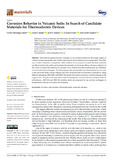Corrosion behavior in volcanic soils: in search of candidate materials for thermoelectric devices
Fecha
2021Autor
Versión
Acceso abierto / Sarbide irekia
Tipo
Artículo / Artikulua
Versión
Versión publicada / Argitaratu den bertsioa
Impacto
|
|
10.3390/ma14247657
Resumen
Thermoelectric generators have emerged as an excellent solution for the energy supply of volcanic monitoring stations due to their compactness and continuous power generation. Nevertheless, in order to become a completely viable solution, it is necessary to ensure that their materials are able to resist in the acidic environment characteristic of volcanoes. Hence, the main objective of this work ...
[++]
Thermoelectric generators have emerged as an excellent solution for the energy supply of volcanic monitoring stations due to their compactness and continuous power generation. Nevertheless, in order to become a completely viable solution, it is necessary to ensure that their materials are able to resist in the acidic environment characteristic of volcanoes. Hence, the main objective of this work is to study the resistance to corrosion of six different metallic materials that are candidates for use in the heat exchangers. For this purpose, the metal probes have been buried for one year in the soil of the Teide volcano (Spain) and their corrosion behavior has been evaluated by using different techniques (OM, SEM, and XRD). The results have shown excessive corrosion damage to the copper, brass, and galvanized steel tubes. After evaluating the corrosion behavior and thermoelectric performance, AISI 304 and AISI 316 stainless steels are proposed for use as heat exchangers in thermoelectric devices in volcanic environments. [--]
Materias
Corrosion,
Materials selection,
Soil corrosion,
Thermoelectricity
Editor
MDPI
Publicado en
Materials 2021, 14, 7657
Departamento
Universidad Pública de Navarra/Nafarroako Unibertsitate Publikoa. Institute of Smart Cities - ISC /
Universidad Pública de Navarra. Departamento de Ingeniería /
Nafarroako Unibertsitate Publikoa. Ingeniaritza Saila
Versión del editor
Entidades Financiadoras
This research was funded by the Official School of Industrial Engineers of Navarre, grant reference Fuentes Dutor 2020.






